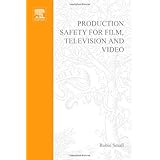
Average Reviews:

(More customer reviews)In the 1980's a Safety director at the Motion Picture and Television Safety Comittee's (Hollywood) office wrote to OSHA asking if an "eye wash" on hand could not substitute for Safety Glasses. In a published letter of interpretation the OSHA offices replied that this "wash" (indicating that the worker had already been hurt by a chemical before the corrective action would be taken) was NOT a substitute for protective lenses. I'm certain this is only one of thousands of reasons
that Production Safety issues needed to be published in the form of a training and reference textbook!
This textbook emphasized logical steps that should be taken on any production to prevent safety violations, accidents, health risks and possible death. In that respect it is useful to an international audience of potential and working filmmakers.
Whatever "Small" criticism I have of this 480 page text must be qualified with this statement: Somebody really needed to write a text on production safety for the film industry! This author's effort should be applauded, loudly! This is one h--- of a compilation of material about safety laws! BUT (big but), by targeting this specifically at the British and European audience Mr. Small missed a major marketing opportunity.
By "targeting" I not only mean that this text lists a compilation of British and European Union laws related to different aspects of safety and filming, but also that he makes reference in this text to "cases" and accidents by name. The cases are named without explanation of the facts of that case. He assumes knowledge by the reader, probably from the British press who he quotes often. I personally don't read the British Press here in the States. With the monopolization of the film industry by the media we don't even hear that many reports about violations of safety on a film set unless they result in a death!
Mr. Small's grammar contains colloquialisms that are quaint but not appropriate for an instructional text. It was an error on the part of the Editors in allowing these to be left in this excellent training manual! In repeated instance Mr. Small spells tires as "tyres". The Editor's were apparently ASleep at the wheel when reveiwing this text. I also found acronyms used repeatedly in sections of this text that were not in the acronym appendix. That is confusing and unclear.
This text is a training and reference book, as such it should be held to a high standard of grammatical criticism, teaching communications to identify and prevent health and safety risks appears to be a goal of this text's author.
In the U.S. (United States) our equivalent to many of the British laws are found in the O.S.H.A. (Occupational Safety and Health Administration) handbook which is available on CD ROM (ROM does not stand for Royal Ontario Museum).
Robin Small's text goes into incredible detail to enable his reader to recognize and prevent possible safety violations. It also contains often overlooked (see the example of the Safety Committee paragraph 1) but common sense thinking about Safety in a film/tv/video production. It's a 4 on a scale of 1-5, and as soon as I learn how to spel I'll write a book about why identifying all the safety risks is useless if you're not enpowered to fire violators, including chemically handicapped stars, and as one photographer's wife called him, "pigs" who don't listen to knowledgeable persons of the opposite sex!
Click Here to see more reviews about: Production Safety for Film, Television and Video
Covering all aspects of production safety, this is an invaluable reference guide for the independent programme maker, freelancer, manager, producer, tutor and student filmmaker. Robin Small identifies all the major risks and gives advice on how to control and/or eliminate them. Each hazard section includes useful references to the relevant legislation, documents and licences, as well as addresses of organisations for essential advice and recommended further reading. An appendix lists samples of vital certificates, with visual references provided on www.focalpress.com. Important information about hazard identification, risk assessment and safety policy is provided in the chapters covering legislation, health and safety management, personal protective equipment and insurance. Particular hazards are then split into individual sections for ease of reference. These hazards include:AsbestosCranesExplosives and pyrotechnicsFood and cateringManual handing and liftingVisual display screensWorking at heightsThe appendices provide comprehensive contact information for UK and European Heath and Safety sources. They also include sample forms to draw up your own safety system.Robin Small is Senior Lecturer in Television, Media Department at the University of Huddersfield.Learn how to identify potential hazards and control and/or eliminate them.Gain fast access to legislation and procedure.Make use of the essential documentation contained on the CD and website.
Click here for more information about Production Safety for Film, Television and Video

0 comments:
Post a Comment